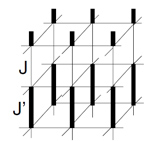Home > Press > Numerical validation of quantum magnetic ordering: Numerical simulations designed to confirm the magnetic characteristics of 3D quantum materials largely match the theoretical predictions
 |
Abstract:
A new study set out to use numerical simulations to validate previous theoretical predictions describing materials exhibiting so-called antiferromagneting characteristics. A recently discovered theory shows that the ordering temperature depends on two factors -- namely the spin-wave velocity and the staggered magnetization. The results, largely consistent with these theoretical predictions, have now been published in a paper in EPJ B by Ming-Tso Kao and Fu-Jiun Jiang from the National Taiwan Normal University, in Taipei.
Numerical validation of quantum magnetic ordering: Numerical simulations designed to confirm the magnetic characteristics of 3D quantum materials largely match the theoretical predictions
Heidelberg, Germany and New York, NY | Posted on October 22nd, 2013In antiferromagnetic materials, the spins of electrons align in a regular pattern pointing in opposite directions to their neighbours. The materials' magnetic ordering conditions the temperature, referred to as the Néel temperature, above which the macroscopic magnetic ordering is no longer present.
The authors attempted to confirm a new universal law established between the thermal and quantum properties of these three-dimensional quantum antiferromagnets. Specifically, the law suggests that the Néel temperature can be related to the staggered magnetisation density near a quantum critical point (QCP). At that point, there is a special class of continuous magnetic phase transition taking place at the absolute zero of temperature, driven by quantum-level fluctuations.
In order to produce quantitative predictions, they simulated a specific three-dimensional relevant model using the first principles of approximation-free Monte Carlo calculations. The authors thus extracted the Néel temperature, the zero-temperature staggered magnetisation in the system and the spinwave velocity.
They found that the universal relation is valid to a great extent, while there is a discrepancy between the theoretical predictions and the simulation results. Further investigation, they believe, is required in order to better understand the discrepancy. For example, this could mean investigating whether the predicted universal relation is valid qualitatively or quantitatively for the same type and different type of quantum phase transitions occurring in other models than that considered here.
####
For more information, please click here
Contacts:
Franziska Hornig
49-622-148-78414
Copyright © Springer
If you have a comment, please Contact us.Issuers of news releases, not 7th Wave, Inc. or Nanotechnology Now, are solely responsible for the accuracy of the content.
| Related Links |
| Related News Press |
News and information
![]() Researchers develop molecular qubits that communicate at telecom frequencies October 3rd, 2025
Researchers develop molecular qubits that communicate at telecom frequencies October 3rd, 2025
![]() Next-generation quantum communication October 3rd, 2025
Next-generation quantum communication October 3rd, 2025
![]() "Nanoreactor" cage uses visible light for catalytic and ultra-selective cross-cycloadditions October 3rd, 2025
"Nanoreactor" cage uses visible light for catalytic and ultra-selective cross-cycloadditions October 3rd, 2025
Physics
![]() Quantum computers simulate fundamental physics: shedding light on the building blocks of nature June 6th, 2025
Quantum computers simulate fundamental physics: shedding light on the building blocks of nature June 6th, 2025
![]() A 1960s idea inspires NBI researchers to study hitherto inaccessible quantum states June 6th, 2025
A 1960s idea inspires NBI researchers to study hitherto inaccessible quantum states June 6th, 2025
![]() Magnetism in new exotic material opens the way for robust quantum computers June 4th, 2025
Magnetism in new exotic material opens the way for robust quantum computers June 4th, 2025
Discoveries
![]() Researchers develop molecular qubits that communicate at telecom frequencies October 3rd, 2025
Researchers develop molecular qubits that communicate at telecom frequencies October 3rd, 2025
![]() Next-generation quantum communication October 3rd, 2025
Next-generation quantum communication October 3rd, 2025
![]() "Nanoreactor" cage uses visible light for catalytic and ultra-selective cross-cycloadditions October 3rd, 2025
"Nanoreactor" cage uses visible light for catalytic and ultra-selective cross-cycloadditions October 3rd, 2025
Announcements
![]() Rice membrane extracts lithium from brines with greater speed, less waste October 3rd, 2025
Rice membrane extracts lithium from brines with greater speed, less waste October 3rd, 2025
![]() Researchers develop molecular qubits that communicate at telecom frequencies October 3rd, 2025
Researchers develop molecular qubits that communicate at telecom frequencies October 3rd, 2025
![]() Next-generation quantum communication October 3rd, 2025
Next-generation quantum communication October 3rd, 2025
![]() "Nanoreactor" cage uses visible light for catalytic and ultra-selective cross-cycloadditions October 3rd, 2025
"Nanoreactor" cage uses visible light for catalytic and ultra-selective cross-cycloadditions October 3rd, 2025
Quantum nanoscience
![]() ICFO researchers overcome long-standing bottleneck in single photon detection with twisted 2D materials August 8th, 2025
ICFO researchers overcome long-standing bottleneck in single photon detection with twisted 2D materials August 8th, 2025
![]() Programmable electron-induced color router array May 14th, 2025
Programmable electron-induced color router array May 14th, 2025
|
|
||
|
|
||
| The latest news from around the world, FREE | ||
|
|
||
|
|
||
| Premium Products | ||
|
|
||
|
Only the news you want to read!
Learn More |
||
|
|
||
|
Full-service, expert consulting
Learn More |
||
|
|
||








